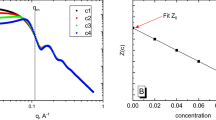key words
It is shown experimentally that the weight of a crystal of rutile depends on its spatial orientation. The observed difference in the apparent masses of the crystal is explained by the fact that the interaction factor of the elastic and gravitational forces depends on the direction with respect to the crystallographic axes of the sample.
Similar content being viewed by others
REFERENCES
A. L. Dmitriev E. M. Nikushchenko V. S. Snegov (2003) Izmer. Tekh. 2 8
A. L. Dmitriev (2001) Izv. Vyssh. Ucheb. Zaved., Fiz. 12 65
N. March M. Parinello (1980) Collective Effects in Solids and Liquids Mir Moscow
M. P. Shaskol’skii (Eds) (1982) Acoustic Crystals Nauka Moscow
Additional information
Translated from Izmeritel’naya Tekhnika, No. 9, pp. 36–37, September, 2004.
Rights and permissions
About this article
Cite this article
Dmitriev, A.L., Chesnokov, N.N. Mass measurements. Meas Tech 47, 899–901 (2004). https://doi.org/10.1007/s11018-005-0011-6
Received:
Issue Date:
DOI: https://doi.org/10.1007/s11018-005-0011-6




